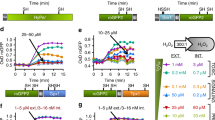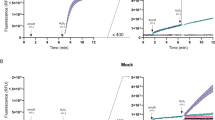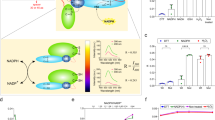Abstract
Genetically encoded probes based on the H2O2-sensing proteins OxyR and Orp1 have greatly increased the ability to detect elevated H2O2 levels in stimulated or stressed cells. However, these proteins are not sensitive enough to monitor metabolic H2O2 baseline levels. Using yeast as a platform for probe development, we developed two peroxiredoxin-based H2O2 probes, roGFP2-Tsa2ΔCR and roGFP2-Tsa2ΔCPΔCR, that afford such sensitivity. These probes are ∼50% oxidized under 'normal' unstressed conditions and are equally responsive to increases and decreases in H2O2. Hence, they permit fully dynamic, real-time measurement of basal H2O2 levels, with subcellular resolution, in living cells. We demonstrate that expression of these probes does not alter endogenous H2O2 homeostasis. The roGFP2-Tsa2ΔCR probe revealed real-time interplay between basal H2O2 levels and partial oxygen pressure. Furthermore, it exposed asymmetry in H2O2 trafficking between the cytosol and mitochondrial matrix and a strong correlation between matrix H2O2 levels and cellular growth rate.
This is a preview of subscription content, access via your institution
Access options
Subscribe to this journal
Receive 12 print issues and online access
$259.00 per year
only $21.58 per issue
Buy this article
- Purchase on Springer Link
- Instant access to full article PDF
Prices may be subject to local taxes which are calculated during checkout






Similar content being viewed by others
References
Sies, H. Role of metabolic H2O2 generation: redox signaling and oxidative stress. J. Biol. Chem. 289, 8735–8741 (2014).
Rhee, S.G. Cell signaling. H2O2, a necessary evil for cell signaling. Science 312, 1882–1883 (2006).
Finkel, T. Signal transduction by reactive oxygen species. J. Cell Biol. 194, 7–15 (2011).
Fujikawa, Y., Morgan, B. & Dick, T.P. in Oxidative Stress and Redox Regulation (eds. Jakob, U. & Reichmann, D.) 119–156 (Springer, 2013).
Ludescher, C. et al. Detection of activity of P-glycoprotein in human tumour samples using rhodamine 123. Br. J. Haematol. 82, 161–168 (1992).
Huai-Yun, H. et al. Expression of multidrug resistance-associated protein (MRP) in brain microvessel endothelial cells. Biochem. Biophys. Res. Commun. 243, 816–820 (1998).
Belousov, V.V. et al. Genetically encoded fluorescent indicator for intracellular hydrogen peroxide. Nat. Methods 3, 281–286 (2006).
Gutscher, M. et al. Proximity-based protein thiol oxidation by H2O2-scavenging peroxidases. J. Biol. Chem. 284, 31532–31540 (2009).
Schwarzländer, M., Dick, T.P., Meyer, A.J. & Morgan, B. Dissecting redox biology using fluorescent protein sensors. Antioxid. Redox Signal. 10.1089/ars.2015.6266 (2015).
Bilan, D. & Belousov, V. HyPer family probes: state of the art. Antioxid. Redox Signal. 10.1089/ars.2015.6586 (2016).
Ferrer-Sueta, G. et al. Factors affecting protein thiol reactivity and specificity in peroxide reduction. Chem. Res. Toxicol. 24, 434–450 (2011).
Delaunay, A., Pflieger, D., Barrault, M.B., Vinh, J. & Toledano, M.B. A thiol peroxidase is an H2O2 receptor and redox-transducer in gene activation. Cell 111, 471–481 (2002).
Sobotta, M.C. et al. Peroxiredoxin-2 and STAT3 form a redox relay for H2O2 signaling. Nat. Chem. Biol. 11, 64–70 (2015).
Fomenko, D.E. et al. Thiol peroxidases mediate specific genome-wide regulation of gene expression in response to hydrogen peroxide. Proc. Natl. Acad. Sci. USA 108, 2729–2734 (2011).
Sobotta, M.C. et al. Exposing cells to H2O2: a quantitative comparison between continuous low-dose and one-time high-dose treatments. Free Radic. Biol. Med. 60, 325–335 (2013).
Huang, B.K. & Sikes, H.D. Quantifying intracellular hydrogen peroxide perturbations in terms of concentration. Redox Biol. 2C, 955–962 (2014).
Peskin, A.V. et al. The high reactivity of peroxiredoxin 2 with H2O2 is not reflected in its reaction with other oxidants and thiol reagents. J. Biol. Chem. 282, 11885–11892 (2007).
Schröder, E. et al. Crystal structure of decameric 2-Cys peroxiredoxin from human erythrocytes at 1.7 Å resolution. Structure 8, 605–615 (2000).
Hall, A., Karplus, P.A. & Poole, L.B. Typical 2-Cys peroxiredoxins--structures, mechanisms and functions. FEBS J. 276, 2469–2477 (2009).
Ghaemmaghami, S. et al. Global analysis of protein expression in yeast. Nature 425, 737–741 (2003).
Morgan, B. et al. Multiple glutathione disulfide removal pathways mediate cytosolic redox homeostasis. Nat. Chem. Biol. 9, 119–125 (2013).
Gutscher, M. et al. Real-time imaging of the intracellular glutathione redox potential. Nat. Methods 5, 553–559 (2008).
Bode, M. et al. Inaccurately assembled cytochrome C oxidase can lead to oxidative stress-induced growth arrest. Antioxid. Redox Signal. 18, 1597–1612 (2013).
Merz, S. & Westermann, B. Genome-wide deletion mutant analysis reveals genes required for respiratory growth, mitochondrial genome maintenance and mitochondrial protein synthesis in Saccharomyces cerevisiae. Genome Biol. 10, R95 (2009).
Gomes, F., Tahara, E.B., Busso, C., Kowaltowski, A.J. & Barros, M.H. Nde1 deletion improves mitochondrial DNA maintenance in Saccharomyces cerevisiae coenzyme Q mutants. Biochem. J. 449, 595–603 (2013).
Davidson, J.F. & Schiestl, R.H. Mitochondrial respiratory electron carriers are involved in oxidative stress during heat stress in Saccharomyces cerevisiae. Mol. Cell. Biol. 21, 8483–8489 (2001).
Ezeriņa, D., Morgan, B. & Dick, T.P. Imaging dynamic redox processes with genetically encoded probes. J. Mol. Cell. Cardiol. 73, 43–49 (2014).
Stone, J.R. & Yang, S. Hydrogen peroxide: a signaling messenger. Antioxid. Redox Signal. 8, 243–270 (2006).
Morgan, B., Sobotta, M.C. & Dick, T.P. Measuring EGSH and H2O2 with roGFP2-based redox probes. Free Radic. Biol. Med. 51, 1943–1951 (2011).
Janke, C. et al. A versatile toolbox for PCR-based tagging of yeast genes: new fluorescent proteins, more markers and promoter substitution cassettes. Yeast 21, 947–962 (2004).
Meyer, A.J. & Dick, T.P. Fluorescent protein-based redox probes. Antioxid. Redox Signal. 13, 621–650 (2010).
Acknowledgements
We acknowledge funding from the German Research Foundation (DFG) Priority Program (SPP) 1710 and the DFG Collaborative Research Center (SFB) 1036 to T.P.D., and a DKFZ visiting scientist fellowship to B.M.
Author information
Authors and Affiliations
Contributions
T.P.D., B.M. and K.V.L. conceived the project. B.M., K.V.L. and T.N.E.O. performed most experiments. D.E., D.P.-F., P.S.A. and A.T. contributed to experiments. T.P.D., B.M. and K.V.L. analyzed the data and wrote the manuscript.
Corresponding authors
Ethics declarations
Competing interests
The authors declare no competing financial interests.
Supplementary information
Supplementary Text and Figures
Supplementary Results, Supplementary Figures 1 – 15 and Supplementary Tables 1 and 2. (PDF 2499 kb)
Rights and permissions
About this article
Cite this article
Morgan, B., Van Laer, K., Owusu, T. et al. Real-time monitoring of basal H2O2 levels with peroxiredoxin-based probes. Nat Chem Biol 12, 437–443 (2016). https://doi.org/10.1038/nchembio.2067
Received:
Accepted:
Published:
Issue Date:
DOI: https://doi.org/10.1038/nchembio.2067
This article is cited by
-
Deciphering the mechanism of glutaredoxin-catalyzed roGFP2 redox sensing reveals a ternary complex with glutathione for protein disulfide reduction
Nature Communications (2024)
-
Lighting the light reactions of photosynthesis by means of redox-responsive genetically encoded biosensors for photosynthetic intermediates
Photochemical & Photobiological Sciences (2023)
-
A puromycin-dependent activity-based sensing probe for histochemical staining of hydrogen peroxide in cells and animal tissues
Nature Protocols (2022)
-
Defining roles of specific reactive oxygen species (ROS) in cell biology and physiology
Nature Reviews Molecular Cell Biology (2022)
-
Genetically encoded tools for measuring and manipulating metabolism
Nature Chemical Biology (2022)



